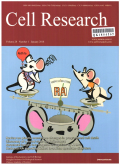- 钛学术文献服务平台 \
- 学术期刊 \
- 基础科学期刊 \
- 生物科学期刊 \
- 细胞研究(英文版)期刊 \
Cryo-EM structure of constitutively active human Frizzled 7 in complex with heterotrimeric Gs
Cryo-EM structure of constitutively active human Frizzled 7 in complex with heterotrimeric Gs
基本信息来源于合作网站,原文需代理用户跳转至来源网站获取
摘要:
Dear Editor,
The ten mammalian Frizzleds (FZD1-10) belong to the class F of G protein-coupled receptors (GPCRs) and mediate WNT signaling through interaction with transducer proteins including Dishev-elled (DVL) or heterotrimeric G proteins.1 Their involvement in human disease has put FZDs at the forefront of drug targets,especially anti-cancer therapy.2 However,no drugs have been developed for efficient pharmacological modulation of FZDs,partially owing to the limited understanding of FZD structure and activation mechanisms.1,3 Among class F,FZD7 is intensively pursued due to its relevance in various tumor models,particularly in intestinal cancers.4 Detailed structures of the receptor complexes would allow for structure-guided discovery of new drug candidates.FZD1-10 share structural similarity with the related class F member Smoothened (SMO),which mediates Hedgehog signaling and is a validated target for cancer therapy.2 In an effort to understand the structural basis of FZD activation and transducer interaction,we solved the structure of human FZD7 in complex with heterotrimeric mini Gs (mGs).

推荐文章
Incorporation of silica into the goethite structure: a microscopic and spectroscopic study
Quartz
Goethite
Twinned goethite
Microscopic characterization (FESEM and TEM)
FT-IR spectroscopy
基于complex moment的圆度测量和图像检索
complex moment
圆度测量
梯度
图像结构相似度
图像检索
关于Active Worlds在教育领域中的应用
虚拟世界
教育
Active Worlds
内容分析
关键词云
关键词热度
相关文献总数
(/次)
(/年)
引文网络
引文网络
二级参考文献 (0)
共引文献 (0)
参考文献 (0)
节点文献
引证文献 (0)
同被引文献 (0)
二级引证文献 (0)
2021(0)
- 参考文献(0)
- 二级参考文献(0)
- 引证文献(0)
- 二级引证文献(0)
引文网络交叉学科
相关学者/机构
期刊影响力
细胞研究(英文版)
主办单位:
中国科学院上海生化细胞所
出版周期:
月刊
ISSN:
1001-0602
CN:
31-1568/Q
开本:
16开
出版地:
上海岳阳路319号中科院上海生命科学研究院31B,401室
邮发代号:
4-645
创刊时间:
1990
语种:
eng
出版文献量(篇)
2692
总下载数(次)
0
总被引数(次)
40708
期刊文献
相关文献
推荐文献
- 期刊分类
- 期刊(年)
- 期刊(期)
- 期刊推荐
力学
化学
地球物理学
地质学
基础科学综合
大学学报
天文学
天文学、地球科学
数学
气象学
海洋学
物理学
生物学
生物科学
自然地理学和测绘学
自然科学总论
自然科学理论与方法
资源科学
非线性科学与系统科学
细胞研究(英文版)2022
细胞研究(英文版)2021
细胞研究(英文版)2020
细胞研究(英文版)2019
细胞研究(英文版)2018
细胞研究(英文版)2017
细胞研究(英文版)2016
细胞研究(英文版)2015
细胞研究(英文版)2014
细胞研究(英文版)2013
细胞研究(英文版)2012
细胞研究(英文版)2011
细胞研究(英文版)2010
细胞研究(英文版)2009
细胞研究(英文版)2008
细胞研究(英文版)2007
细胞研究(英文版)2006
细胞研究(英文版)2005
细胞研究(英文版)2004
细胞研究(英文版)2003
细胞研究(英文版)2002
细胞研究(英文版)2001
细胞研究(英文版)2000
细胞研究(英文版)2021年第9期
细胞研究(英文版)2021年第8期
细胞研究(英文版)2021年第7期
细胞研究(英文版)2021年第6期
细胞研究(英文版)2021年第5期
细胞研究(英文版)2021年第4期
细胞研究(英文版)2021年第3期
细胞研究(英文版)2021年第2期
细胞研究(英文版)2021年第12期
细胞研究(英文版)2021年第11期
细胞研究(英文版)2021年第1期

 免费查重
免费查重










